Complex of anti-torpedo protection "Package-E / NK"
The first works in the direction of creating a promising complex of anti-torpedo protection started in the mid-eighties. By this time, a number of important technologies had emerged, which allowed starting work on new complex projects. Several enterprises of the Soviet defense industry were involved in the preliminary work. In the nineties, started the development of new projects and testing technologies in the framework of various tests. For example, in 1998, the first successful tests took place, during which the prototype of the anti-torpedo successfully intercepted the training torpedo.
According to reports, several research and development organizations were involved in the project, which received the designation “Package-E / NK”. Thus, the means of destruction were developed on a competitive basis by the Central Research Institute "Hydropribor" and the State Scientific Production Enterprise "Region" with the assistance of the Scientific and Research Institute of Morteplotechnika. In the end, the military chose the version of the project SNNP "Region", which was subsequently finalized and went into series. Currently, the company "Region" is part of the Corporation "Tactical Missile Weapons."
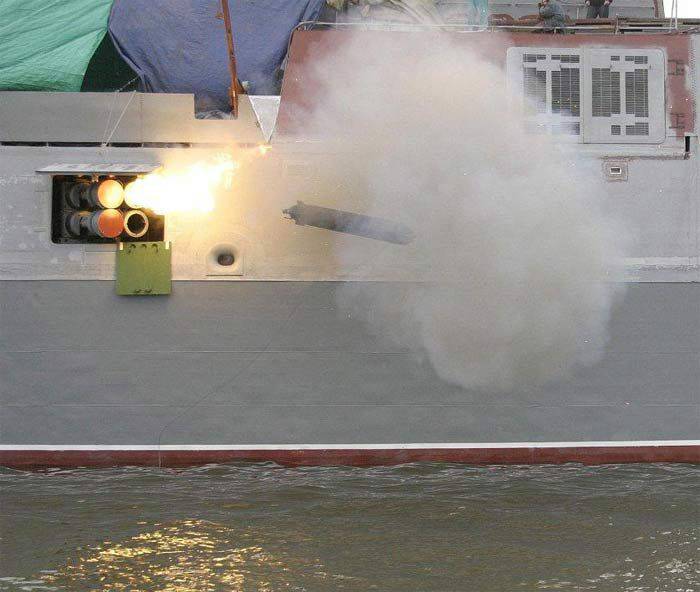
Corvette "Steregushchy" uses the package-E / NK complex. Photo Militaryrussia.ru / Forums.airbase.ru
The project “Package-E / NK” had two main goals. It was necessary to create a system capable of complementing the existing means of anti-submarine defense of ships, as well as performing the tasks of protecting the ship from the enemy's torpedo weapons. Such requirements had a great influence on the composition of the promising complex. Thus, in addition to the launcher and other equipment installed on the base ship, the thermal torpedo of the MTT type and the anti-torpedo M-15 were included in the “Package-E / NK” system. it weapon designed to solve various combat missions.
For certain reasons, the amount of information about the Package-E / NK complex until a certain time left much to be desired, although the models of its individual elements were shown at exhibitions from the middle of the last decade. Detailed information about this system appeared only in the last few years. It is now known that in 2010, the anti-torpedo defense complex was adopted by the Navy. In the future, information appeared on the imminent supply of such complexes for installation on new ships being built for the Russian Navy. In addition, data on the offer of the Package-E / NK complex to foreign customers was published.
Ship systems of the complex
According to the manufacturer, the carrier ship of the Package-E / NK complex is completed with several main nodes. This is a launcher, a set of control systems, as well as a hydroacoustic station (GAS) of target designation "Package-AE". All of this equipment ensures the timely detection of underwater targets, such as submarines or torpedoes, as well as the issuance of target designation to means of destruction and their subsequent use. The composition of the complex can be changed in accordance with the wishes of the customer.
To search for targets, it is proposed to use the Packet-AE hydroacoustic station, created in the Aquamarine company (St. Petersburg). In some sources, GUS is referred to as the whole complex - “Package-E / NK”. With the help of a set of special equipment, the station should search and detect underwater objects, both submarines and torpedoes. When a target is detected, the GAS automatics are able to independently determine its type and target designation to torpedoes or anti-torpedoes.
It is known that there are two variants of a hydroacoustic station, differing from each other in the number and configuration of antennas. So, the version with a cylindrical antenna weighs 352 kg and provides an overview of the sector width 270 °. When using two flat antennas, the weight of the station is reduced to 127 kg, but the field of view is reduced to 90 °.
According to some data, for the use of the Package-E / NK complex, the carrier ship can use both its own sonar detection tools and instruments included in this system. In both cases, the control system of the complex processes the signals from the gas and outputs data on the torpedo or anti-torpedo. Next, using the launcher is the launch of the appropriate means of destruction.
The launch of the MTT torpedoes and the M-15 anti-torpedoes is carried out using the CM-588 universal launcher with launch tubes with a diameter of 324 mm. Depending on the type of carrier ship and other factors, the launcher may have 1, 2, 4 or 8 tubes for ammunition. In all cases, the pipes are fixed on a movable base, providing a horizontal pickup within a small sector. Vertical guidance launcher is not provided.
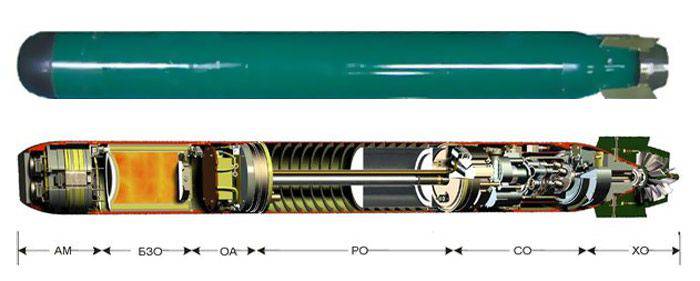
The layout of the torpedoes MTT. Figure Militaryrussa.ru
Ejection of a torpedo or anti-torpedo is made using a powder accumulator of pressure. Before firing, the ship must open the corresponding lazport, then the approximate aiming of the launcher in the direction of the target is made, after which the pyrotechnic charge throws ammunition from the launch tube. After leaving the launcher, a torpedo or anti-torpedo falls into the water and begins to search for a target with its own equipment.
Torpedoes and anti-torpedoes of the “Package-E / NK” complex can be used in any meteorological conditions with sea state no more than 5 points. There are restrictions on wind speed - up to 20 m / s. During the launch of a torpedo, the carrier ship can move at speeds up to 20 nodes. It is not allowed to launch torpedoes or anti-torpedoes at a sea depth of less than 40 m.
Torpedo MTT
The Package-E / NK complex is capable of fighting both torpedoes and enemy submarines. For the destruction of enemy submarines, it includes the MTT small-sized thermal torpedo, also known as the “Baby”. This weapon was developed specifically for the Package-E / NK complex, however, according to some sources, it has not yet become the standard weapon of this system installed on domestic ships. Nevertheless, some reports on the use of the complex suggest that the MTT product was still adopted.
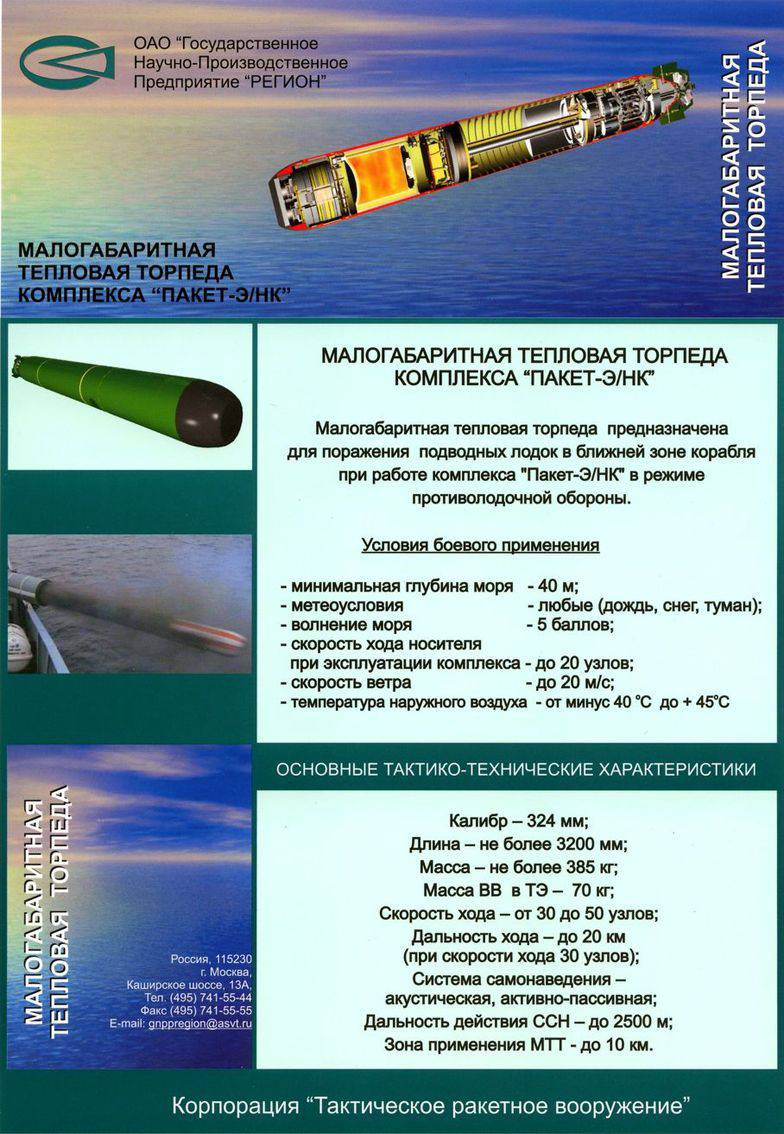
Promotional materials on the torpedo MTT. Photo Bastion-karpenko.ru
The development of small-sized torpedoes for the Package-E / NK complex started at the beginning of the 2000th years. Several organizations were engaged in the creation of this weapon: the State Research and Production Enterprise "Region", the Research Institute of Marine Technology and the Dagdizel plant. The purpose of the research work with the code "Baby" was the creation of a torpedo, which could be used against submarines and surface ships of the enemy. In addition, the authors of the project should take into account the specific requirements of the customer regarding the dimensions and weight of the product.
As a result of the work, a promising torpedo with a length of 3,2 and a caliber of 324 mm appeared. Product weight - 390 kg, of which the order of 60 kg falls on the explosives of the warhead. Despite its small size, the torpedo has a classic layout for such weapons. The head part of the case is given under the instrumental compartment with automatic guidance, behind it is a combat charging compartment, the center of the case is placed under the fuel tanks, and the tail part contains the engine.
The MTT product is equipped with an acoustic guidance system developed by the State Scientific Production Enterprise “Region”. This system allows you to detect enemy underwater objects at distances up to 2,5 km. The maximum detection range is achieved at water depths up to 200 m. At greater depths, the range is reduced to 1200 m. Acoustic guidance system works in conjunction with inertial. The latter provides access to the target area during launch over a long distance. After an exit to the set area guidance is made by means of the speaker system.
In the tail part of the torpedo is a thermal axial piston engine. This unit operates on a unitary type fuel permeated and is connected to the jet propulsion unit. On the aft end of the hull is mounted a water cannon with a propeller and an annular casing. On the sides of the casing, several rudders are provided to control the depth and direction.
Torpedo "Baby" is able to dive to a depth of 600 m and work in two modes, different speed and some other parameters. Maximum travel speed (first mode) - 50 nodes. There is also a second mode with a speed of up to 30 nodes. The maximum range of travel - 20 km.
Light weight and dimensions make it possible to use the MTT torpedo as an weapon for surface ships, submarines and aircraft. In the case of surface ships, launchers of the SM-588 type are used. In addition, it is possible to use the MTT product as a warhead for anti-submarine missile systems of ships and submarines. aviation carriers must use appropriate holders, etc. equipment.
According to available data, at the end of the last decade, the MTT small-sized thermal torpedo was offered to foreign customers, but there is no information on the supply of this weapon yet. Some sources mention the delivery of MTT torpedoes to the navy of Russia, but details are not given.
Antitorpeda M-15
Product M-15 is a specialized torpedo designed to intercept enemy torpedo weapons. Some peculiarities of its design are connected with this, due to the need to enhance a number of characteristics. Thus, according to open data, the anti-torpedo M-15 has a greater maximum depth of turn in comparison with MTT. At the same time, however, it has a shorter range.
The antitorpeda M-15 is almost the same in size as the MTT torpedo. Its length does not exceed 3,2 m, diameter - 324 mm. The starting weight of the product is about 400 kg. Apparently, the overall layout of the two torpedoes also coincides, but there are noticeable differences associated with the units used. Thus, the anti-torpedo has a head hardware compartment, behind which the warhead is located, and in the tail is the engine. In the tail part of the body provides a set of steering wheels for control during movement.
The MTT torpedo and anti-torpedo M-15 are equipped with acoustic guidance systems, active-passive type. The range of the guidance system is 400 m.
In order to ensure rapid acceleration to maximum speed and rapid destruction of the detected torpedo, the M-15 product is equipped with a jet engine. In the body of the engine is a charge hydroreactive solid fuel. Thus, when anti-torpedoes get into the water, the fuel combustion reaction begins, leading to the formation of thrust. This provides fast acceleration, although it limits the maximum travel range. According to reports, the M-15 is able to accelerate to 50 nodes, the range does not exceed 1400 m. The effective range is about half the size. Structural strength allows diving on 800 m.
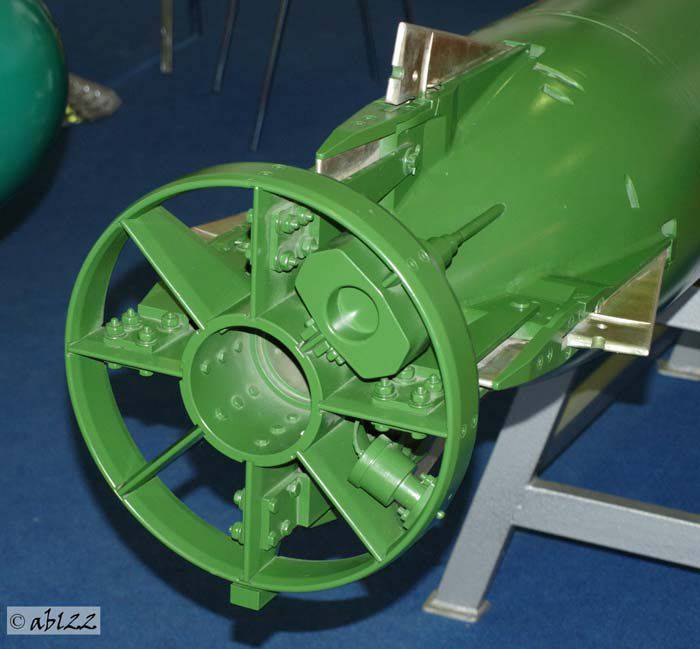
Anti-torpedo tail with nozzle and rudders. Photo ABL22, Military.tomsk.ru/forum
To destroy the enemy's torpedoes, a high-explosive warhead with a charge of 80 kg weight is used.
According to the method of use, the anti-torpedo M-15 does not differ from the MTT product in the version of the armament of surface ships. When an enemy's torpedo is detected, the automation of the Package-E / NK complex must enter the necessary data into the anti-torpedo, direct the launcher and launch. The release of the product from the launch tube is carried out by a powder pressure accumulator. After exiting the pipe, the anti-torpedo falls into the water and begins searching for a target.
Exploitation
The Package-E / NK anti-torpedo protection complex can be used on various surface ships, in the construction of which there is a place for the installation of a launcher and other equipment. Thus, the carriers of this complex can be various ships of domestic and foreign construction.
In 2010, the Package-E / NK complex was adopted by the Russian Navy. Soon became aware of the installation of its equipment on ships of several types. Thus, on the corvettes of the 20380 and 20385 projects, the use of two launchers with four tubes on each is envisaged. The frigates of the 22350 project, in turn, must carry two launchers with six tubes each.
The Package-E / NK complex is offered to foreign customers. In this case, it can be installed on foreign-made ships. In addition, there are domestic projects of export ships, the armament of which initially provides for a complex of anti-torpedo protection. For example, several years ago, the Northern PKB presented a project for the 21956 destroyer armed with the Packet-E / NK system. The possibility of using such weapons in other ship projects designed specifically for export was also mentioned.
The ships of the Russian Navy are actively using new anti-torpedo weapons during training. For example, in June 2014, the corvette "Steregushchy" (20380 Ave.) at one of the sites in the Baltic Sea took part in training activities on the search and destruction of a submarine of a conditional enemy, which was played by the newest submarine of the 636.3 project. The crew of the ship successfully detected a conditional enemy and made a training launch of a torpedo at the Package-E / NK complex. Apparently, the MTT torpedo was used in a training configuration. The conditional enemy was destroyed.
Later on, the Russian ships participated in maneuvers several times and used the Package-E / NK complex. So, in October 2015, the corvette “Boky” (eg 20380) used the anti-torpedo M-15 in the course of the exercise and successfully defended itself against the attack of a conditional opponent.
To date, the Package-E / NK anti-torpedo protection complexes have been installed on several new ships of the Russian fleet. In addition, several other ships are being built, in the armament of which these systems are included. Thus, the newest complex, which replaces the old jet-propelling bombs, is gradually becoming the main means of protecting modern ships from enemy torpedoes. Such modernization allows solving several tasks at once, first of all, to increase the level of protection of ships against torpedo armament.
On the materials of the sites:
http://ktrv.ru/
http://bastion-karpenko.ru/
http://arms-expo.ru/
http://bmpd.livejournal.com/
http://militaryrussia.ru/blog/topic-470.html
http://militaryrussia.ru/blog/topic-482.html
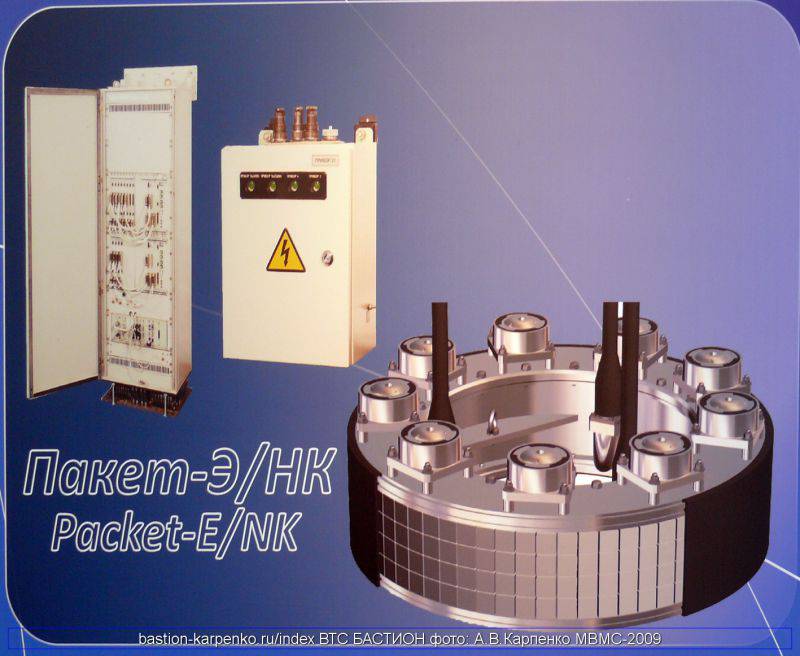
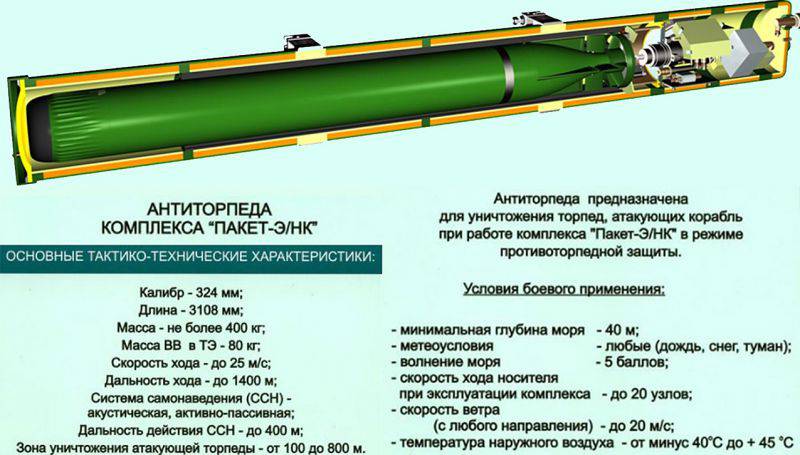
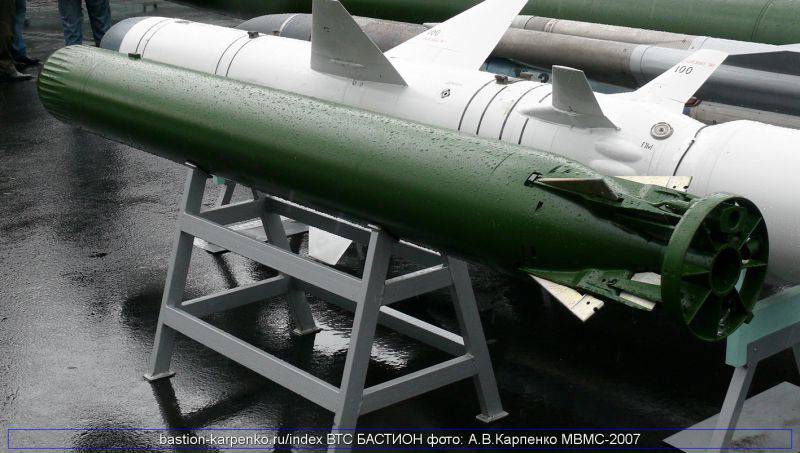
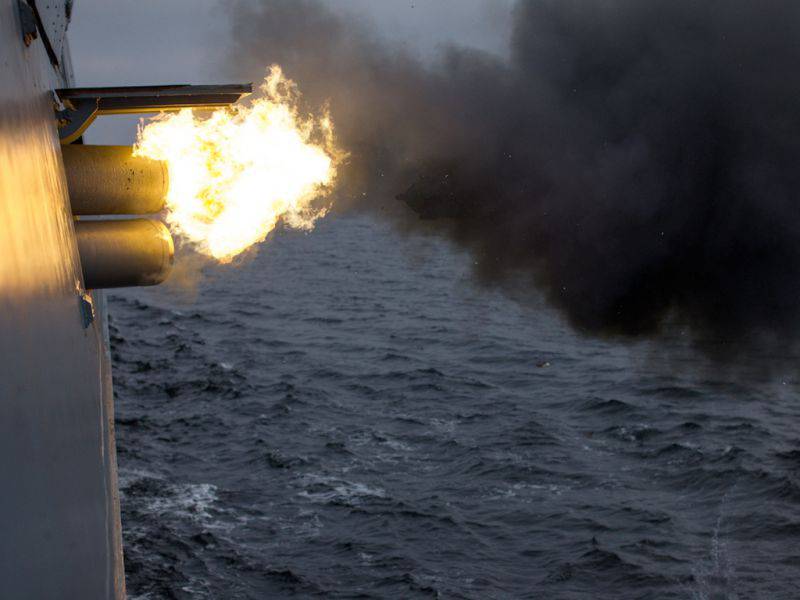
Information